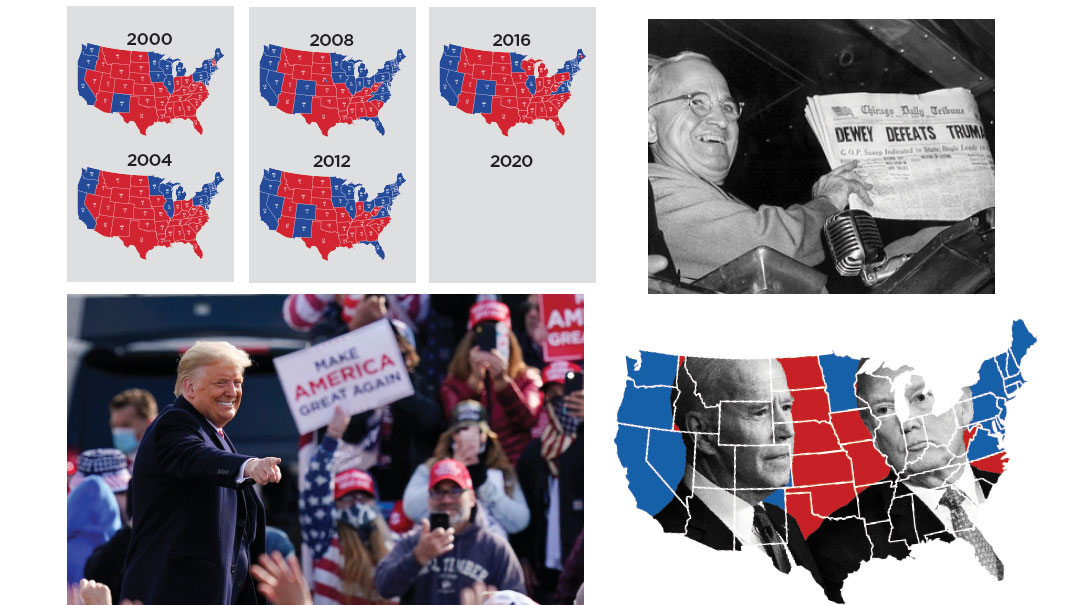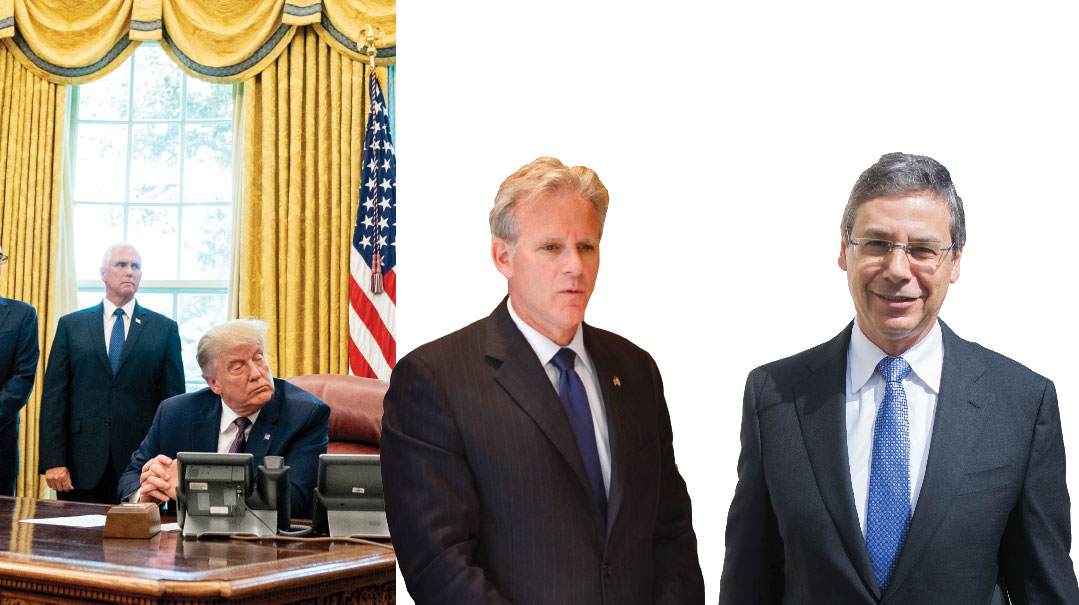It’s Crunch Time

Pollsters and pundits are writing off President Trump, just as they were dismissive of candidate Trump in 2016. What are the chances that 2020 will be a replay of 2016?

One year after Donald Trump shocked the world, and maybe even himself, by winning the presidential election in 2016, I clambered onstage at the annual Israeli journalists’ conference in Eilat as the American expert invited to enlighten an Israeli audience still astounded by Trump’s victory and perturbed by the disruptive style he projected from the Oval Office.
In my final summation, I made a bold prediction.
I told the audience that Trump would win reelection in 2020.
Why did I feel so strongly about it? My take was that Trump would deliver exactly what he promised to his voters; he would succeed in delegitimizing the liberal Democratic opposition; and in the last 100 years, most presidents have won a second term.
How do I feel about my 2020 vision today, a week before Election Day?
There’s an old saying that’s applicable here. No guts, no glory. It was supposedly coined by US Air Force Major General Frederick Blesse during the Korean War in the 1950s. I still have the guts, but when it comes to glory — I’d rather be smart than right. The smarter you are, the better chance you have of being correct, so let’s crunch some numbers and see what direction they lead us in.
Allow me to make one important disclaimer first.
I am writing this the day before we go to print, using today’s poll numbers. Some of them will have shifted by the time you read this.
In addition, for those who read my column two weeks ago, you know I’m working under the assumption that the polls — not all, but in aggregate — provide reasonably accurate and useful information. Yes, there are quacks in every profession, including polling. However, in his October 20 article for Real Clear Politics (RCP), the RCP’s senior elections analyst Sean Trende cited another expert whose work I respect — Nate Silver of the FiveThirtyEight blog. Trende wrote that in 2014, Silver released his database of 6,614 polls published in the closing days of an election between 1998 and 2014. The overall tilt of these polls, on average, was biased by just 0.7 points toward the Democrats.
“That’s not zero,” wrote Trende, “but it isn’t enough to appreciably alter the outcome of the election either.”
So when the polls show Joe Biden ahead by 8.1% in the popular vote, I’m assuming he probably leads Trump by no less than 7.4%.
The good news for Trump is that the popular vote is relatively meaningless. The only tally that matters is in the Electoral College, and whoever gets 270 votes there is the winner. The Electoral College works on a state-by-state basis. The polls in individual states often use sparse survey samples and are therefore usually not as accurate as the national polls. Not every pollster who surveys the nation surveys each state individually, and that’s why results in certain states sometimes differ by more than the usual margin of error of 3% to 5%.
In 2016, Trump lost the popular vote 48%-46% (third-party candidates siphoned off about 5% of the vote) but he won 306 electoral votes, 36 more than he needed to win.
Which means Trump can lose 36 electoral votes from his 2016 total and still win reelection.
So if we want to really understand his chances of keeping his job, it pays to review the states Trump won in 2016 that he’s at risk of losing in 2020.
Flipping Real Estate

Before we go there, I want to put this all in perspective.
Presidents who win a second term, at least in recent history, generally win and lose the same states they won and lost the first time around.
When Bill Clinton won reelection in 1996, only three states (Colorado, Georgia, and Montana) flipped from voting for Clinton in 1992 to voting against him in 1996. By flipping Arizona and Florida in his favor, Clinton ended up winning nine more electoral votes in 1996 than in 1992.
George W. Bush, another two-term president who won by razor-thin margins both times, gained eight electoral votes in 2004 over his 2000 total by flipping Iowa and New Mexico in his favor, while losing New Hampshire. (Bush also gained seven additional electoral votes in 2004 from states he won in 2000, due to reapportionment of electors as a result of the 2000 census.)
In 2012, Barack Obama lost only two states that he had won in 2008, Indiana and North Carolina. And USA Today reported that out of America’s 3,100 counties, only 208, or 7%, switched allegiances from one party to the other in 2012 compared to 2008.
What emerges from this is that in the most recent presidential elections, the number of states that actually flip when a president runs for reelection are few and far between. No fewer than two and no more than five.
Of course, that was then and this is now.
During my years as a stockbroker, the one disclaimer I was legally required to tell clients was that past performance is no guarantee of future trends.
In the same article I cited earlier, Sean Trende said the same thing in his own professional parlance, noting that people are always searching for patterns with data and that sometimes, we do it in obviously bad ways.
“There was a cottage industry of predicting presidential elections based on the winner of the final Redskins football game from 1932 to 2004 (there’s actually a statistically significant correlation between the margins of those games and the margin of presidential elections during this time),” Trende wrote. “But where it’s most dangerous is when we have good reason for believing that there has to be a pattern.”
What are the polls showing us today? As of press time, the Real Clear Politics average polls showed Joe Biden ahead in states with 232 electoral votes, Trump leading in states with 125 electors, and there are 181 that rate as toss-ups.
If you eliminate all the toss-up states by assigning them to the candidate with even a slim lead, the picture looks grim for Trump, with Biden potentially running away with the race by 357-181 victory. However, as I quoted Trende saying two weeks ago, Trump’s average job approval rate is about 45%. Incumbents with a 45% approval rate don’t normally lose by a landslide.
A Sleeper State
So I’m going to attack this from a slightly different angle.
To me, the best way to crunch Trump’s chances is to start with the fact that he won 306 electoral votes in 2016. He can afford to shed 36 of them and still win.
Overall, if you look at the polls in the 11 states RCP rates as toss-ups, with 181 electoral votes up for grabs, Trump’s position is eerily similar to where he stood a week before the 2016 election.
At this point, what I’m going to do is compare Trump’s final margin of victory in those states in 2016 with how he is faring in the polls today, in light of how he was doing a week before the 2016 election.
Let’s suffice with two important examples. In 2016, Trump trailed Hillary by 5.2% in Pennsylvania. Trump ended up winning Pennsylvania’s 20 electoral votes by 0.7%. This year, Trump trails Biden by 5.1%. So he’s doing about the same compared to 2016.
In Florida, another state that Trump won by 1.2%, Biden’s lead over Trump at this stage is only slightly higher (1.5%) than Hillary’s (0.8%). Biden’s margin over Hillary’s (0.7%) is not enough to overcome the percentage by which Trump won Florida by in 2016.
So it’s still reasonable to assume that Trump holds on to both of these states and keeps their combined 49 electoral votes.
However, in 2016, Trump also flipped Michigan’s 16 electoral votes into the Republican column. This year, it’s more likely that Biden wins Michigan. His lead there is 7.8% compared to Hillary’s 6.2% at this stage. Trump eked by in Michigan by 0.3%.
So let’s lop off 16 electoral votes from Trump’s 306, bringing him down to 290.
Are there any other states Trump won last time but is at risk of losing this time? In my model, in any state where Biden is polling ahead of Hillary by a greater margin than Trump’s 2016 victory won the state with, I will assign that state to the Biden column.
There is only one more, Iowa. There, Biden leads Trump by 0.8% and at this time of year in 2016, Trump led Hillary by 1.4%. That’s a total 2.2% shift in the Democrats favor. However, Trump ended up winning Iowa by 9.5%, outperforming the polls by a whopping 8%!
Considering that Iowa has voted Democratic in six of the last eight presidential elections, I will stick with my model, and will assign Iowa’s six electoral votes to Biden, reducing Trump’s 2016 total further to 284. That’s still enough for him to stay in D.C. for four more years.
Here are a couple of more toss-up states that are competitive but less likely to flip.
North Carolina. Trump won North Carolina by 3.5% in 2016, even though Hillary led him in the polls by 2.5% in the final week. Biden’s lead over Trump is slimmer, just 1.5%, so once again Trump trails, but he is well within the margin of error that he overcame to win the state in 2016.
In Wisconsin, Trump won by 0.7%, even though Hillary led in the polls by 6.5%. Biden’s lead in Wisconsin is only 4.6%, almost 2% less than Hillary’s.
So in my model, these two states, with 25 electoral votes total, are favored to remain Republican — and they must for Trump to win.
I realize this is not exactly scientific. I’m applying my own brand of logic. There may be demographic changes I’m not taking into account between 2020 and 2016 that affects the final results. There could be local issues and races that bring out more or fewer voters in key states compared to last time. For example, both Iowa and North Carolina have vulnerable incumbent Republican senators fighting for their lives in races rated as dead heats.
But considering again that very few states tend to flip away from the incumbent, and Biden’s poll numbers are worse than Hillary’s in almost all of the toss-up states he needs to win, Trump can absorb the loss of Michigan and Iowa and still win reelection.
But he can’t afford to lose anything else. Getting back to Pennsylvania for a moment, while I assumed above that Trump pulls it out of the hat as he did last time, Biden does have the same 5% lead that Hillary blew. Biden was born in Pennsylvania, so maybe that’s enough of an edge over Hillary so that he hangs onto his lead, and wins its 20 electoral votes, knocking Trump down to 264 and sending him back to Manhattan. I don’t see any states that Trump lost in 2016 that he can win this year, at least according to my model.
The polls close in Pennsylvania at 8 p.m. EST on election night, so if you need to go bed early, and can’t wait up all night for results, it’s somewhat safe to assume that if the networks make an early call on Pennsylvania, you can probably go to sleep knowing the winner of Pennsylvania will be sworn in on Pennsylvania Avenue on January 20, 2021.
A Few Postscripts
The Impact of Early Voting
As of press time, some 56 million Americans have already cast their ballots. That’s at least 20% ahead of the 2016 early voting figures, which means there are fewer people whose minds can be changed between now and election day. That would tend to indicate there will be fewer last-minute shifts in the polls compared to 2016. Expect early voting to become even more popular in future years, as more people opt for convenience and flexibility over rigidly sticking to tradition. If there are issues with validity of mail-in ballots, both states and the US Postal Service will have to become more adept at handling them as the years go by.
The Shy Trump Voter
Some pollsters say the reason why Trump’s victory surprised in 2016 was due to the “shy Trump voter,” or folks who were embarrassed to tell pollsters they were voting for a reality TV star and real estate developer with a ton of excess baggage. Not that Hillary Clinton was a paradigm of virtue, but there was some logic to this. I remember corresponding by email with an old friend who was politically connected in several states prior to the election and asking him who he was voting for.
His answer: Republican. I found that a bit vague, so I asked him point-blank if that meant Trump. It took two more emails to wheedle a yes out of him, so I have my own anecdotal evidence of at least one shy Trump voter.
However, Trump’s been president for four years now. To contend that there are still shy Trump voters who won’t admit their support for Trump strikes me as far-fetched. If there’s a poll that still insists that’s of value, I would look at other polls.
Dreadlock in D.C.
Even if Trump wins, chances are he will face a blue Congress. Republicans’ 53-47 Senate majority is in jeopardy. The RCP Senate map shows seven of the nine seats rated as toss-ups are controlled by Republicans, which means they have more to lose than gain. Officially, RCP shows the Republicans with a 46-45 lead, plus those nine toss-ups, but if you assign the tossups to whoever is currently leading, no matter how slim that lead may be, it shows the Democrats winning the Senate by 51-49.
That’s great news for Joe Biden if he can pull off a victory, but Real Bad News for President Trump, who will grow even more frustrated without a friendly Senate, or at least one controlled by his own party, to run interference for him.
If the Republicans lose the Senate, it will make them even more eager to reposition themselves for 2024. So knowing Trump will be a lame duck, Republicans will be announcing their candidacy for the 2024 presidential nomination earlier than ever, and Trump will have to share the limelight with them, something that always rubs the president the wrong way.
The Biggest Miss Ever
Everyone remembers the iconic photo of a smiling Harry Truman holding up the very premature banner headline of the Chicago Daily Tribune, “Dewey Defeats Truman.” When all the votes were counted, Truman in fact won by 4.5%, and garnered 303 electoral votes to Dewey’s 189.
The newspaper failed in its gamble to call the election and get the scoop on everyone, but how did the pollsters get it all wrong? There were only three main pollsters in those days, Gallup, Roper, and Crossley, who all had the Republican Dewey trouncing Truman by five to fifteen percentage points
What went wrong? Most of the deficiencies have been corrected in the intervening 70 years, but mainly, the pollsters grew complacent. The Gallup Poll ceased polling for presidential job approval in May 1948, six months before the election, after Truman’s had dropped precipitously from his May 1947 high of 65% to just 39%.
Polling had just begun in earnest in the 1930s, and pollsters grew accustomed to Franklin Delano Roosevelt, who won four consecutive elections, and assumed that voter sentiment changed little in the last few weeks of a campaign, something we now know to be untrue.
Why Job Approval Matters
One impediment to President Trump’s reelection is his job approval rating, hovering at less than 45% in the Real Clear Politics average. Why is this number so important?
It makes sense that voters who approve of a president’s job performance will vote for him, while those who feel the president’s doing a lousy job will vote for his opponent.
Historically, the statistics back this up.
Gallup, who’s corrected the mistakes they made in the 1948 Dewey-Truman race, showed that before President Eisenhower’s 1956 reelection, his approval rating had soared to 75%.
Lyndon Johnson was also riding high in the saddle at 70% before his reelection in 1964. Both Richard Nixon and Ronald Reagan were at 62% in November 1972 and November 1984, respectively, en route to their reelections, and Bill Clinton was at 58%.
Presidents who failed to win a second term all suffered from low voter approval. Gerald Ford was right where Trump is now, at 45%, and ended up losing 50%-48%, to Jimmy Carter.
The same fate befell Carter in November 1980, when his approval rating sank to 31%. He ended up outperforming his approval rating, getting 41% of the vote, but still lost badly.
George H.W. Bush was at 43% approval in November 1992, and ended up with just 38% of the vote in a year when a strong third-party candidate, H. Ross Perot, captured 19% of the vote.
Gallup’s conclusion: “An incumbent president with job approval ratings below 50% would seem to have lower odds of being reelected.”
(Originally featured in Mishpacha, Issue 833)
Oops! We could not locate your form.










